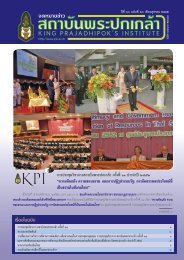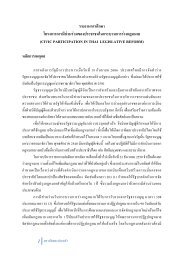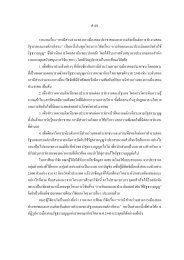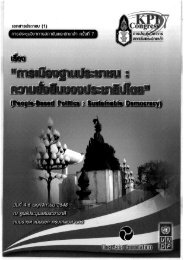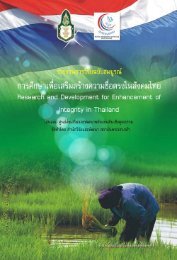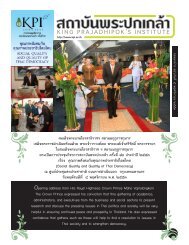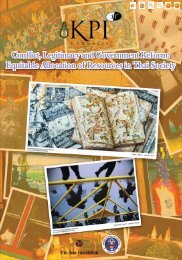SUFFiciENcy EcONOMy ANd GRASSROOtS DEvElOPMENt
SUFFiciENcy EcONOMy ANd GRASSROOtS DEvElOPMENt
SUFFiciENcy EcONOMy ANd GRASSROOtS DEvElOPMENt
Create successful ePaper yourself
Turn your PDF publications into a flip-book with our unique Google optimized e-Paper software.
The Meaning of Sufficiency Economy <br />
International Conference<br />
217<br />
Such a stance is, I suspect, most manifest among people who live in or were<br />
born in rural communities. The rural population of the country is still largely<br />
concentrated in northeastern Thailand. I will in this paper argue that the economy of<br />
northeastern Thai villages is a product of practices that are primarily oriented<br />
towards a global capitalist system, but which are also tempered by Buddhist ideals. I<br />
will draw on research which I have carried out for more than four decades in a rural<br />
community in Mahasarakham province in the center of the northeastern region to<br />
demonstrate that villagers there have fully embraced capitalist development in<br />
seeking to improve their own lives and/or those of their children and descendants. At<br />
the same time, I will also show that their success in the capitalist economy has for<br />
many been a consequence of an ethic that is rooted in village Buddhism. I will show<br />
further how practices and institutions associated with village Buddhism provide a<br />
sense of sanctuary from the vicissitudes of volatile capitalist economic forces. The<br />
dialectical practices of Buddhist and capitalist economies found in rural northeastern<br />
Thai society contrasts, I suggest, with the untempered capitalist ethic that is<br />
particularly manifest among the Thai urban middle class. <br />
<br />
A NEARLY SELF-SUFFICIENT ISAN VILLAGE<br />
Ban Nông Tün: A Central Isan Village<br />
In 1963-64 Jane Keyes, my wife (who took most of the photos I will show),<br />
and I first undertook fieldwork in rural northeastern Thailand. We chose a village in<br />
what I term the Isan rural heartland – the provinces of Khon Kaen, southern Udorn,<br />
Kalasin, Mahasarakham, Roi-Et, Yasothon, western Ubon, northern Surin, Sisaket,<br />
and Buriram, Chaiyaphum and northern Khorat. In this region the vast majority of<br />
people have long based their livelihood on the cultivation of glutinous rice in rainfed<br />
fields. They traditionally supplemented their diet with fish caught in the Chi and<br />
Mun rivers, but few in this central Isan region, unlike villagers living near the<br />
Mekong, depended primarily on fishing for their living. They also differ from<br />
villagers in the more hilly areas of the region – Loei, eastern Kalasin, Sakon<br />
Nakhon, and parts of Nakhon Phanom and Mukdahan – where lowland wet-rice<br />
cultivation is more difficult. <br />
The people of the Isan heartland are predominantly Thai-Lao, that is, they are<br />
speakers of dialects closely related to those found in central and southern Laos and<br />
have long followed cultural traditions which are also the same as those found in<br />
these areas of Laos. They differ in culture and language from the peoples of southern<br />
Sisaket, Surin and Buriram whose primary languages are Khmer or Kui, another<br />
Mon-Khmer language as well as from the people of Khorat who speak dialects<br />
related to central Thai.



